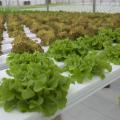Should I use supplemental lighting to increase my yield?
The short answer to this question is no. However, if you want to understand the basis for this recommendation, read through this explanation. In order for supplemental lighting to increase yield, it must be bright enough to significantly increase photosynthesis. This means using High Intensity Discharge (HID) lamps giving about 1,000 foot candles each (or 400 watts, or 120 micromoles per square meter). One such lamp would be needed for each 40 square feet of greenhouse floor space. Therefore, in a 2,500 square foot greenhouse, a grower would need 62 lamps. Each lamp costs about $200. Therefore, the fixed costs (up front expenses) would be about $12,500 for a single bay greenhouse. But, then you would need to turn them on, too. Assume that you use these 62 lamps 12 hours each day, and 10 months of the year. Each lamp would provide about 425 watts, including the ballast. If your electricity costs 10 cents per kWh, your annual electric bill would be about $9,617. (If your electic cost is less than 10 cents per kWh, feel free to adjust this calculation.)
If you think you can increase your yield in the first year to bring in at least an additional $22,117, then you will more than break even. This would mean getting an additional 35 lbs. per plant (based on 500 plants in the greenhouse and selling at $1.25 per lb.). On the other hand, see the short answer above.
Publications
News
RAYMOND, Miss. -- Current and prospective greenhouse vegetable growers can learn about the specialized production method during Mississippi State University’s 2024 Greenhouse Vegetable Short Course on Feb. 27-28. The course will be held at the North Mississippi Research and Extension Center’s Magnolia Building in Verona from 8 a.m. to 5 p.m. each day. It is open to greenhouse vegetable producers throughout the Southeast.
STARKVILLE, Miss. -- Vegetable growers soon will have two chances to learn about managing pests on produce in greenhouses and high tunnels.
There’s nothing more satisfying than homegrown tomatoes. You don’t have to be a gardening expert to grow delicious tomatoes in your backyard. Here are a few tips that will help you grow the best looking (and tasting) tomatoes out there:


